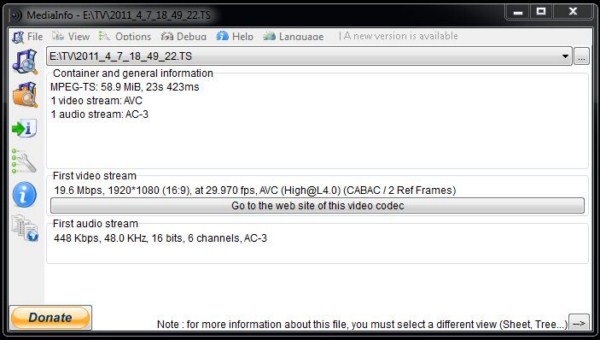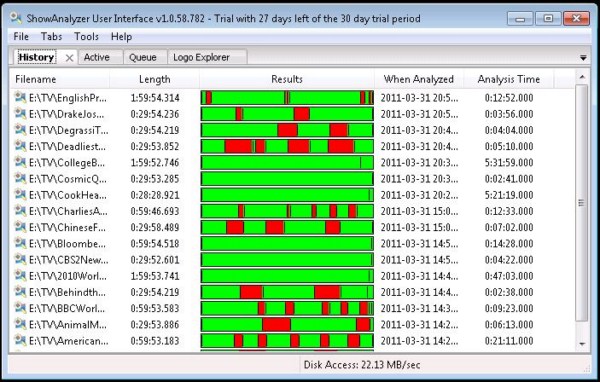Hauppauge Colossus: HD PVR with HDMI Support
by Andrew Van Til on April 14, 2011 5:40 PM EST- Posted in
- HTPC
- Home Theater
- Hauppauge
Testing and Evaluation
With an original HD PVR and Ceton InfiniTV 4 Digital Cable Tuner (DCT) on hand, it provided us with the opportunity to record the same content using MediaInfo and perform visual inspections to document differences in quality. For the results above, the Colossus and HD PVR were configured in-line using the YPbPr/TOSLINK pass-through from the STB. They were set to use the highest recording profile in SageTV, with SageDCT used to capture the raw TS stream from the InfiniTV 4 as a reference point. The settings used by the various devices are summarized in the following table.
| Device Recording Profile Summary | |||
| Video Resolution | Colossus | HD PVR | SageDCT (RAW) |
| 480i | 3985 Kbps 720x480@29.97 AVC (Main@L3.2) (CABAC/2 Ref Frames) | 4695 Kbps 720x480@29.97 AVC (Main@L3.1) (CABAC/4 Ref Frames) | 2948 Kbps 528x480@29.97 MPEG2 (Main@Main) |
| 720p | 7924 Kbps 1280x720p@59.94 AVC (High@L4.0) (CABAC/2 Ref Frames) | 11.8 Mbps 1280x720@59.94 AVC (Main@4.0) (CABAC/4 Ref Frames) | 10.5 Mbps 1280x720@59.94 MPEG2 (Main@High) |
| 1080i | 12.7Mbps 1920x1080i@29.97 AVC (High@L4.0) (CABAC/2 Ref Frames) | 11.7Mbps 1920x1080i@29.97 AVC (High@L4.0) (CABAC/4 Ref Frames) | 16.5 Mbps 1920x1080@29.97 MPEG2 (Main@High) |
There are differences in the bitrate and AVC profiles used by the two Hauppauge devices; the Colossus uses a higher rate for 1080i and the HD PVR uses higher bitrates for 720p and 480i. The InfiniTV 4 was a third set of values. With three points of reference and digital source content, there is little noticeable difference between the captured files in real terms. (If you’re interested in seeing clips of the videos, let us know and we’ll see about including download links.
Alongside the comparative testing, the Colossus was also evaluated for the overall quality and “watchability” of recordings captured at native resolution from the STB. We recorded sixty files with a 33% distribution per resolution at random intervals and channels, and then sampled at five to ten points in each file for issues related to audio and video. We looked for A/V synchronization problems, stutter, and dropouts, and the final result is an 8.33% fail rate. Most of the “fail” issues only occurred in specific locations in the files, and while annoying they were not severe enough to abandon playback. However, there were also entire recordings with no audio or significant enough issues with audio drops or video playback that continued viewing was very unpleasant or impossible.

Before moving on it is interesting to note that the maximum bitrate available in ShowBiz and via the encoder’s property page (shown below) is quite a bit higher (~20Mbps) than what is used by SageTV when selecting the best rate (~14 Mbps). It is unlikely that the value of encoding at this high a level would result in a great enough pay off to justify the increased file size given the bitrate of most TV content, but it is good to know that it is possible if the content warrants it.
Additional Testing
I love it when my interests in the HTPC space overlap, so having observed the difference in bitrate capabilities and issues with file capture it provided an easy excuse to start writing code against the Colossus and figure out how to drive the device. For anyone who has done any playing with DirectShow, the following screenshot of the capture graph in GraphStudio should be very familiar. It demonstrates the four components necessary to enable file capture from the device with the property pages for the “Capture” and “Encoder” filters (which are what ShowBiz exposes through its GUI) displayed. The file sink—the component at the end that writes the TS packets to disk as they are output from the encoder (in this case a slightly customized version of the “Dump” sample included in the Windows SDK)—is the only filter not provided by the drivers.

Using that as a starting point I wrote a simple application to prototype input selection (it supports component + S/PDIF or HDMI) and filter configuration. Using standard DirectShow interfaces, I was able to reproduce both the capture issues and the inconsistent bitrate values observed with ShowBiz and SageTV, where after setting the device to the maximum bitrate (~20Mbps) through the encoder interface it actually uses ~14Mbps. I have asked Hauppauge to provide documentation for programming against the device in case there is a different, non-obvious, mechanism for configuring the card, but they did not provide it in time for this review. For anyone interested in looking at the source code for the application it is available here.

Anyone who made the jump to the original HD PVR when it was released will remember that the commercial scanning story was a bit troubled. Fortunately, the work that was done to support the AVC TS files created with it carries over to those generated using the Colossus. Applications like ShowAnalyzer are able to scan the files and detect commercials in them.










60 Comments
View All Comments
silverblue - Friday, April 15, 2011 - link
I'll rephrase that... I bought a card in 2004 which suddenly became unsupported, so there were no new drivers for it even before Vista came out. It's actually one of my reasons for not migrating to Windows 7 before now, believe it or not.djfourmoney - Friday, April 15, 2011 - link
I am targeting this. Finally a card I can use with DirecTV HD box! My lack of money and employment will prevent me from being an early adopter, which is fine. I can wait for the kinks to be sorted out before purchase.I also agree that a "White Box" version of the card would be welcomed with a reduced price especially if your going to using it with Sage TV or Windows Media Center.
HDMI to HDMI will completely simplify my HTPC setup, though I would still use DV-I (or VGA) for Video and Toslink for audio out to my HT in-a-box.
digitalgriffin - Friday, April 15, 2011 - link
After buying two different versions of their cards, and FIGHTING continously with the drivers, and inconsistent driver updates and locations, I threw them in the trash as a lesson learned. They NEVER fixed their drivers properly.Their reputation is permenantly damaged with me. And this article just renforces how they really don't care about creating a stable product.
Consider the Hauppage driver quality to be as bad, and always as bad as the ATI Rage days.
Golgatha - Friday, April 15, 2011 - link
They have good long term support, but I will agree that their software bundles and drivers are just awful.chasmetz - Friday, April 15, 2011 - link
MediaPortal will support the Colossus in the upcoming 1.2 Beta -> http://forum.team-mediaportal.com/mediaportal-1-ta...bwooster0 - Friday, April 15, 2011 - link
I had a problem with an HD-PVR that was out of warranty and they fixed it and sent it back to me for free.I am using two Colossus cards. One in an Win 7 box and one in an XP box. They are both working fine but the XP box is doing a better job of recording SD stuff (this might be a sat box set up issue)
There support has been good for me.
Sivar - Friday, April 15, 2011 - link
I've been looking for a good TV card. Hopefully the BSODs are just immature drivers.It is a bit ironic to use a poor image format for the pictures in an article which discusses image quality in a product. You may find this OSS program useful: It helps choose an appropriate image format for best quality at a given size. http://code.google.com/p/imageguide/
For screen captures, JPG is not it.
rcpinheiro - Saturday, April 16, 2011 - link
Any news about the strippers? ;-)Obviously, I mean the HDCP strippers that many expected to appear right after the master key was revealed?
Penti - Sunday, April 17, 2011 - link
They existed long before. http://www.hdfury.com/ has been around a long time now, output from that one is component or RGBHV (VGA basically) though. Obviously alot of others are around. Problem with some of them though is that they might get their keys revoked. So far that hasn't happened to HDfury.Any way you might want a HDMI-splitter as you don't have any HDMI-passthrough feature on the Colossus.
Casper42 - Monday, April 25, 2011 - link
I think what hes really asking, and what I want to know as well, is how hard would it be to use a device like this one and the Cracked HDMI information to basically make a card that spoofs HDCP and will essentially allow you to record anything you want over the incoming HDMI port?I would love to see such a card as fiddling with all the cable cards and stupid rules imposed by Cable Labs is absolutely ridiculous when you can hop on your favorite BitTorrent site and find the content in HD with the commercials stripped like 24 hours after it aired on TV.
One of these days they will understand the battle is one they are going to lose every time and just make it easier for us the consumer rather than thinking they can prevent piracy. I would gladly record locally with commercials as opposed to using BT, but as it stands now, BT is so much easier.